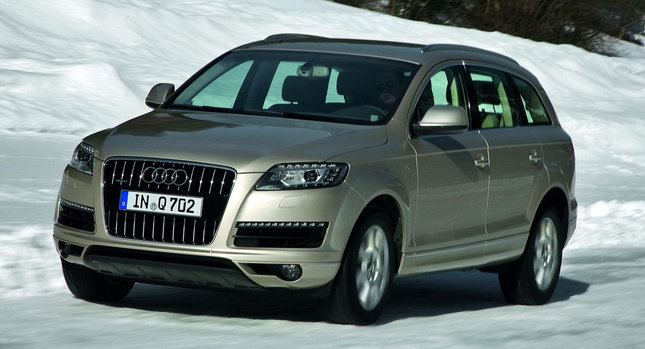Less than a year after the world premiere of the facelifted Q7 at the 2009 Shanghai Auto Show, and Audi is updating its luxury SUV with the introduction of three new V6 engines and an 8-speed tiptronic transmission.
The two gasoline and one diesel V6 combine forced induction and direct fuel injection, while a high-performance recuperation system that recovers energy during braking is also a standard item.
 Starting with the 3.0-liter TFSI, two versions of the supercharged V6 are available. The basic version that replaces the previous 3.6 FSI produces 272HP and 400 Nm (295 lb-ft) accelerating the Q7 to 100km/h (62mph) in 7.9 seconds and on to a top speed of 222 km/h (138 mph), or 225 km/h (139.81 mph) with adaptive air suspension.
Starting with the 3.0-liter TFSI, two versions of the supercharged V6 are available. The basic version that replaces the previous 3.6 FSI produces 272HP and 400 Nm (295 lb-ft) accelerating the Q7 to 100km/h (62mph) in 7.9 seconds and on to a top speed of 222 km/h (138 mph), or 225 km/h (139.81 mph) with adaptive air suspension.
The more powerful version of the 3.0 TFSI that takes the place of the 4.2 FSI V8 generates 333HP and 440 Nm (324.53 lb-ft) between 2,900 and 5,300 rpm. With this engine, the Q7 reaches 100 km/h (62mph) in 6.9 seconds and tops out at 243 km/h (151 mph) or 245 km/h (152mph) when equipped with the adaptive air suspension system.
Audi says that both versions of the 3.0 TFSI are content with 10.7 lt/100km in the combined EU cycle (equal to 22mpg US), representing a 12 and 16 percent reduction respectively over the previous 3.6 FSI and the 4.2 FSI models.
The 2011 Q7 also gets the latest version of Audi’s 3.0-liter V6 turbo diesel engine that weighs 20 kg (44.09 lb) less than the outgoing 3.0 TDI at 198 kg (437 lb.
It churns out 240HP and 550 Nm (406 lb-ft) of torque between 1,750 to 2,500 rpm. This V6 diesel accelerates the Q7 from a standstill to 100 km/h (62 mph) in 7.9 seconds and reaches its top speed at 215 km/h or 134mph while returning 7.4lt/100 km (31.8mpg US) – an improvement of 1.7 l/100 km or 19 percent over the previous 3.0 TDI.
Audi will also offer a second version of the 3.0 V6 TDI dubbed “Clean Diesel” that meets the tougher Euro 6 emission standards. This version uses a DeNox catalytic converter in the exhaust system to reduce the remaining oxides of nitrogen by means of an additive.
It produces 240HP and 550 Nm (406 lb-ft) of torque between 2,000 and 2,250 rpm taking the Q7 from a standstill up to 100 km/h (62mph) in 8.1 seconds and gives it a top speed of 215 km/h or 134mph.
The “Clean Diesel” version is not only slightly slower than the standard 3.0 TDI Q7, but it also consumes more fuel returning an average consumption of 8.4 liters per 100 km, equal to 28mpg US.
Audi also tweaked the 2011 Q7’s 4.2-liter TDI by installing a 2,000-bar fuel injection system and minimizing internal friction. Even though output remains unchanged at 340HP, it now delivers more torque (800Nm or 590 lb-ft vs 760Nm or 560 lb-ft).
It accelerates the Q7 from 0 to 100 km/h in 6.4 seconds and offers a top speed of 242 km/h or 150mph. Furthermore, fuel consumption has been reduced from 9.9lt/100km (23.8 US mpg) to 9.2 lt/100km (25.6 US mpg).
Finally, the German automaker has given all six- and eight-cylinder Q7s a new eight-speed automatic transmission that lowers fuel consumption by about five percent.











